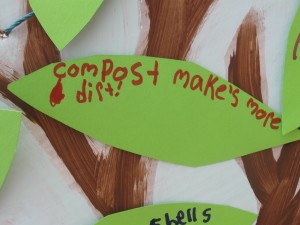Whitney Fenton is an Energy Corps member serving with the Commission on Economic Opportunity in Wilkes Barre, PA. She has been working on the Weatherization Innovation Pilot Program (WIPP). Whitney writes:
Most of my Energy Corps work takes place in other peoples’ houses. I go in, look around, define energy using habits with my client, reflect with the client on how their patterns are working out, and give them the low down about ways to save energy. I give the client a chance to declare specific commitments they are willing to make to save. And finally, I give them some CFL magnets, we high-five, and I move on to the next house.
Okay, so there is more to it than that, but you can learn more about our WIPP program in any of these three places (I recommend the first J):
Keep on keeping on, Hummingbird
Home Energy Monitors for the Win!
In Search of the Missing Dollar
I don’t want to repeat the specifics of the WIPP program. Rather, I want to discuss a situation that occurs in about 3% of the homes that I visit.
The context is me and a client, at a round kitchen table built for four, in the midst of an energy education segment. We’ve just finished looking over and discussing the client’s energy bill. It’s time to relay energy saving tips, so, I breathe deep and jump right in. I give everything I’ve got for my listener, reciting every statistic and estimated savings figure for every suggestion I think he or she can handle. I show charts and graphs, suggest wattages of appliances, and literally sing praises of the energy star rating in the key of E for Efficiency. In these particular homes, though, my clients show me how they’ve surpassed every suggestion I have on their progression toward living with minimum waste. I’ll mention recommended maximum heating season thermostat settings, and my client explains that his or her home is kept about ten degrees lower. I’ll talk about CFL’s and he or she will look over my shoulder and grin as a switch is flipped to an LED bulb somewhere behind me. I’ll talk about the high energy consumption of clothes dryers and my client will scoff and say his or her home has been dryer free for years. These are the clients that I would award A+’s if I had any authority to do so.
Early on in my energy education career, I realized the clients who take energy conservation seriously are more than just stellar students: they’re home owners who understand, research, create, and redefine their habits of energy usage for the environment or parsimony’s sake. These clients can be my teachers. I began closing my education segments by asking clients for additional ways they save on their utility bills… tips that one doesn’t hear very often, but, maybe, should. I asked and I’ve collected some of the unconventional energy saving suggestions here for you today! (Conventional tips are also great!)
1) Heating (the biggest energy cost for homes in Pennsylvania):
1)
b. Start an Ugly Sweater Collection! This one came up after a client

showed me the assortment she keeps for guests who complain her heat is too low. Maybe you thought that trend was over? Personally, though, with fuel prices on the rise, I think this look is here for good. So find the thickest, merino, cable piece you can find and put it on. Then turn down your thermostat a few degrees. It’s easier to heat one person than an entire house and the right sweater can make all the difference.
c. Before you buy a pet… think about what it will do to your heating and cooling bills. Summer is hot, especially, for example, if you live in an un-shaded trailer like the client who suggested this tip. Air conditioning, though, is expensive. Plan out a cost effective way to take care of your animals.
d. Spend time out and about during the daytime so you don’t need to pay as much for heat or air conditioning during those hours. Capitalize on the 19% of energy used by the commercial sector each year.
2) Hot Water (the second highest cost for PA residents):
a. A co-worker met a client who conserved hot water by filling up and using one five gallon bucket of water for each shower rather than filling an entire tub or letting the water run for a full shower. This measure may save anywhere from twenty to more than forty-five gallons per shower! When you think about it, all one really needs is a bucket full of water to get clean, so it’s definitely a good option. In a typical household, showering is the biggest user of hot water.
b. Another tip: turn off your hot water heater when you go away from home for a few or more days. You can save about ten dollars, or so, a week. Why pay for it if you’re not going to use it? It takes about an hour to heat up when you get back home, just make sure it’s full of water when you start it back up.
c. And I’m going to take it a step further, don’t be scared: Turn off your hot water for the summer months! I’ve met three or so clients who do this voluntarily. And I do it too. Ever since my hot water heater was ruined by basement flooding last week. It’s been really great, though. It’s a quick way to wake up and get your metabolism going, to find refreshment from summer heat, and, personally, my hair has never been less frizzy. Also an added benefit: committing to short showers is no problem. Hot water is the second biggest energy user in a home so cutting out this cost is really significant.
d. Do you have trouble getting your kids to take fast showers? Try the Two Song Rule! Let your kids listen to music in the shower, but make it clear, they have a two song limit to the amount of time they can spend.
3) Tips for saving water in general:
a. When you need tap water but also need it to be warmer or cooler before you can use it, don’t waste that running water! Collect it! In a bucket you keep next to your sink. Maybe you can use it to shower, water your plants, wash your car, etc.
b. When cleaning your fish tank, consider using the nutrient rich waste water for feeding your plants. Aquaponics.
4) Your Clothes Dryer:
a. Drying clothes in a dryer can account for 4 to 8% of a household’s annual energy use. Think of all we could save collectively if we all just air dried our clothes! One of my clients explained, though she hated stiff clothes, she also understood the value of avoiding the dryer. She compromised by drying her clothes on a line and then sticking them in her dryer in order to fluff them up afterward.
Ultimately, there are countless ways to be creative in your quest to save energy and minimize waste. I encourage you to come up with your own unconventional ways. Remember, on average, healthy adults and 100 watt light bulbs take the same amount of energy to run. Meanwhile, the daily recommended water consumption value is 2.2 to 3 liters for healthy adults. These are your basic needs, and good ideals to shoot for day to day. Good luck!
 Whitney Fenton graduated in May of 2012 from Gordon College in Wenham, MA with a B.S. in Biology and minors of study in outdoor education and chemistry. She’s held a variety of positions including backpacking trip leader, food service worker, and college Sustainability Tracking, Assessment, and Rating Systems intern. She also participated in landscape ecology research during her undergrad years. This year, she’s looking forward to learning a great deal about energy efficient technology and a chance to invest my education and experience in a mission I love. In her role as an Energy Corps member she will be providing home assessments and education to PA residents seeking to decrease their energy consumption and lower their monthly utility bills. Additionally, she plans to research and develop the Energy Corps’ set of best practices for effectively helping communities reduce their energy consumption.
Whitney Fenton graduated in May of 2012 from Gordon College in Wenham, MA with a B.S. in Biology and minors of study in outdoor education and chemistry. She’s held a variety of positions including backpacking trip leader, food service worker, and college Sustainability Tracking, Assessment, and Rating Systems intern. She also participated in landscape ecology research during her undergrad years. This year, she’s looking forward to learning a great deal about energy efficient technology and a chance to invest my education and experience in a mission I love. In her role as an Energy Corps member she will be providing home assessments and education to PA residents seeking to decrease their energy consumption and lower their monthly utility bills. Additionally, she plans to research and develop the Energy Corps’ set of best practices for effectively helping communities reduce their energy consumption.







